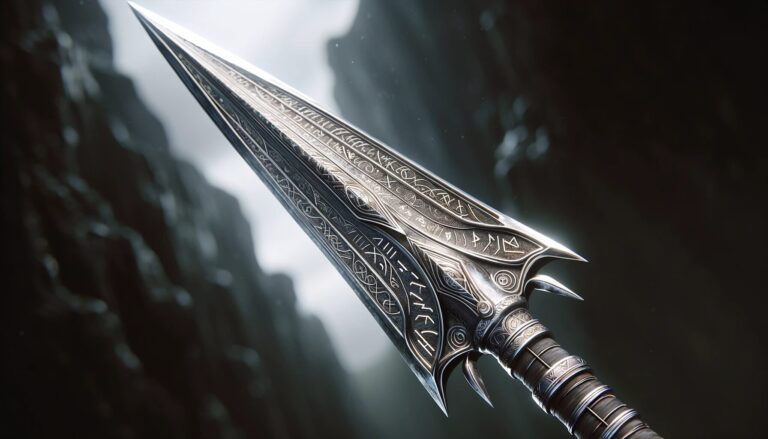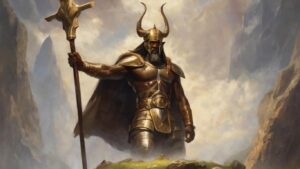Table of Contents
Gungnir stands as one of the most iconic and potent artifacts to ever grace the mythological landscape. Crafted by the skilled dwarven brothers, Brokkr and Sindri, this enchanted spear possesses a rich history, deep symbolism, and a pivotal role in the Norse pantheon.
Origins of Gungnir
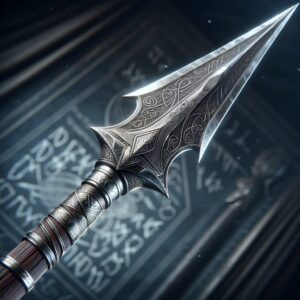
Gungnir’s origin can be traced back to a wager and a challenge. It all began when Loki, the trickster god, dared two gifted dwarves, Brokkr and Sindri, to create a set of divine artifacts, outdoing those forged by the sons of Ivaldi, another group of skilled dwarves. The prize at stake was Loki’s head, a wager he had willingly accepted.
Brokkr and Sindri took up the challenge, channeling their craftsmanship and creativity into crafting a set of three remarkable items: a golden boar, a golden ring that multiplies itself, and, most notably, Gungnir, the spear. Gungnir’s creation was a testament to the dwarves‘ exceptional skills and their determination to outshine their rivals. It was the culmination of their artistry, born from the depths of Svartálfaheim, the realm of the dwarves.
Description of Gungnir
Gungnir stands as an impeccable masterpiece, unparalleled by any other spear in existence. Its appearance exudes divinity. Crafted from a solid piece of pure, enchanted metal, the spearhead renders itself invulnerable and infallible. Its shaft, fashioned from the finest materials, guarantees durability and balance. What truly sets Gungnir apart are its magical properties; it maintains perfect balance and unfailingly hits its mark when thrown, bearing witness to the dwarves’ craftsmanship and their unwavering dedication to the task at hand.
The spear’s physical description, however, is just the tip of the iceberg. Gungnir’s true power lies in its symbolism and the role it plays in Norse mythology.
Symbolism and Significance
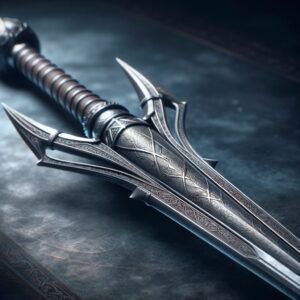
Gungnir carries profound symbolism, representing more than just a formidable weapon. It embodies the essence of Odin, the Allfather and chief of the Norse pantheon. As a symbol of authority, wisdom, and divine might, Gungnir is an extension of Odin’s being and his unwavering commitment to maintaining balance in the cosmos.
One of Gungnir’s most notable attributes is its unerring accuracy, signifying the pursuit of knowledge and wisdom. Moreover, Odin’s unyielding quest for knowledge led him to sacrifice one of his eyes at the Well of Urd, an act symbolized by Gungnir’s precision. This highlights Odin’s willingness to make sacrifices for the greater good, an essential aspect of his character.
Additionally, Gungnir embodies Odin’s role as the god of war and protector of the realms. Its formidable power represents Odin’s commitment to defending the gods and humans from the chaotic forces that threaten the cosmic order. The indestructible nature of Gungnir reflects Odin’s resilience and his ability to withstand the challenges that come his way.
Myths
Gungnir’s significance extends beyond its craftsmanship and symbolism; it plays a pivotal role in several Norse myths and stories. One of the most well-known tales involving Gungnir involves the binding of the wolf Fenrir.
According to Norse mythology, Fenrir, a monstrous wolf destined to bring about great destruction during Ragnarök, the end of the world, needed to be bound to prevent this catastrophe. However, Fenrir was wary of the gods’ intentions and agreed to be bound only if one of the gods placed their hand in his mouth as a sign of good faith.
None but Tyr, the god of law and justice, had the courage to do so. As Fenrir realized he could not break free, he bit off Tyr’s hand. It was during this momentous event that Odin wielded Gungnir to secure Fenrir’s binding, an act that marked the beginning of the end times, Ragnarök.
In another myth, Gungnir plays a crucial role during Odin’s self-sacrifice at the Well of Urd. Seeking to gain unparalleled wisdom and knowledge, Odin hung himself from the branches of Yggdrasil, the World Tree, for nine days and nights. During this ordeal, he pierced his side with Gungnir, sacrificing himself to himself in exchange for the wisdom of the runes. This act of self-sacrifice and Gungnir’s involvement underscores the spear’s role as a conduit for divine power and knowledge.
Gungnir’s presence extends beyond these myths, making appearances in various other sagas and legends of Norse mythology, each time serving as a symbol of Odin’s authority and determination.
Accessibility
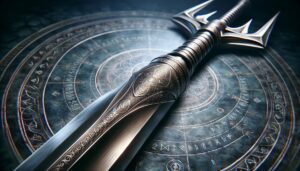
In Norse mythology, the gods consider Gungnir an exclusive artifact. Odin, the Allfather, intrinsically ties it to himself, and he alone wields its power. Therefore, mortals or other beings in the realms of Norse mythology cannot access it. The enchantment and divine essence of Gungnir ensure that it remains in the possession of the Allfather, who can summon it in times of dire need.
Cultural Impact
The legacy of Gungnir extends far beyond the pages of Norse mythology. It has left an indelible mark on literature, art, and popular culture, particularly in the realm of fantasy and mythology. Gungnir’s reputation as an invincible and accurate weapon has inspired countless tales of heroes wielding equally legendary weapons in their quests.
In modern times, Gungnir has made its presence felt in various forms of media, including literature, comics, and movies. Perhaps one of the most notable contemporary representations of Gungnir is in Marvel Comics, where Thor, the God of Thunder, wields a version of the spear. The Marvel Cinematic Universe has further popularized Gungnir’s legacy, introducing it to a global audience and cementing its status as an iconic symbol of power and authority.
FAQ
Who owns Gungnir?
Gungnir is owned and wielded exclusively by Odin, the Allfather of the Norse gods.
What makes Gungnir special?
Gungnir is special because of its perfect craftsmanship, magical properties, and unerring accuracy when thrown.
Can mortals use Gungnir?
No, Gungnir is not accessible to mortals or other beings in Norse mythology; it's meant exclusively for Odin.
What role does Gungnir play in Norse mythology?
Gungnir plays a pivotal role in various Norse myths, including the binding of the wolf Fenrir.
Is there any symbolism associated with Gungnir?
Yes, Gungnir symbolizes Odin's pursuit of knowledge and his willingness to make sacrifices for the greater good.
